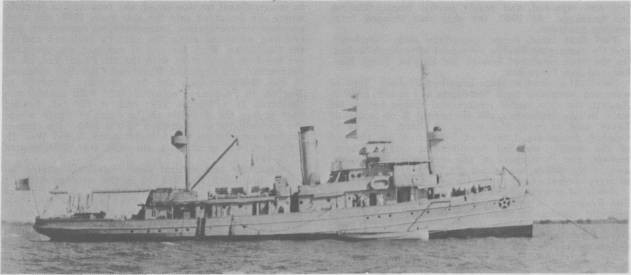Sandpiper I (Minesweeper No. 51)

(Minesweeper No. 51: dp. 840; l. 187'10"; b. 35'6"; dr. 10'4"; s. 14 k.; cpl. 78; a. 2 3"; cl. Lapwing)
A shore bird related to the plovers and snipes.
I
The first Sandpiper, minesweeper no. 51, was laid down on 15 November 1918 at the Philadelphia Navy Yard; launched on 28 April 1919; sponsored by Miss Edith V. Tawresey; and commissioned on 9 October 1919, Lt. E. Murphy in command.
Although built as a minesweeper, Sandpiper performed aircraft tender duties throughout her career. Her assignments moved her from Train, Scouting Fleet; to Aircraft Squadrons, Scouting Fleet; to Aircraft Squadrons, Battle Fleet; to various individual squadrons and finally to patrol units and training commands. Her duties, initially restricted to guarding plane flights, fueling planes, and towing seaplane barges, were gradually expanded. Transportation of aviation spares and personnel came with extended operations and new bases. Salvage and repair duties were added to her search and rescue work and were retained until ships designed for the purpose were built in the 1930's. The minesweeper/aircraft tender, however, was designated AM-51 in July 1920 and retained that hull number for over 15 years. On 22 January 1936, she was officially reclassified as a small seaplane tender and redesignated AVP-9.
Based at New York and then at Norfolk through the 1920's and into the 1930's, Sandpiper operated with the fleet, off the mid-Atlantic and New England coasts during the summer and fall and in the Carribbean and Gulf of Mexico during the winter. Each spring, she returned north. While deployed for winter maneuvers, she participated in annual fleet problems, including problems I (February 1923) and IX (January 1929) in which the use of aircraft allowed the attacking force to break through, and render obsolete, the defenses of the Panama Canal Zone.
In January 1932, Sandpiper was reassigned to the Pacific and, for several years after her arrival on 20 February at San Diego, her new base, she provided services for seaplanes along the west coast. During the summer of 1935, she served with the Navy's Aleutian Survey Expedition as it concluded extensive surveys of the Andreanof and Rat Island groups and used aircraft equipped with multi-lens cameras to expand cartographic data on the chain and to improve methods of aerial photogrammetry.
Toward the end of the decade, Sandpiper shifted to the Canal Zone. From Coco Solo, her duties took her along the Central and South American coasts for survey expeditions and exercises and into the Caribbean for temporary assignments to various patrol units stationed in Cuba, Puerto Rico, and the Virgin Islands. During 1940 and 1941, she was attached to the Caribbean bases, particularly Trinidad, more frequently and for extended periods. With the entry of the United States into World War II, her previously limited escort duties were increased.
Sandpiper remained in the Caribbean into the spring of 1942. She then underwent repairs and overhaul at San Juan and Charleston. In October, she moved north to Boston, whence she continued on to Greenland, arriving at Kangat Bay on 11 November. For the next four months, she conducted escort runs between Kangat Bay and Narssarssuaq; carried out search and rescue missions; and performed local defense duties. In March 1943, she returned to Boston; then, at the end of the month, she proceeded to Casco Bay where she conducted exercises for students at the Antisubmarine Training School. In June, she again moved north to Argentia, whence she escorted and carried aviation fuel for Ranger (CV-4). On the 23d, however, while operating to the south of Cape Farewell, she was rammed on the port quarter by a British merchant ship which tore a hole in her hull and seriously damaged her steering gear. Emergency repairs enabled her to reach Argentia, whence she was routed, via Sydney and Halifax, to Boston to complete the work.
On 28 August, Sandpiper cleared Boston harbor and sailed south to Brazil for duty with Fleet Air Wing 16. She arrived at Recife on 30 September; and, for the next nine months, served as a support ship carrying supplies to various bases along the Brazilian coast. In June 1944, she returned to the United States; underwent overhaul at Norfolk; and, in September, got underway for Key West where she remained, attached to the Training Detachment, Fleet Air Wing 5, until after the end of the war in Europe.
In late June 1945, Sandpiper returned to Norfolk, whence, after brief duty as a target-towing ship, she was ordered to Pearl Harbor. She arrived in Hawaii on 17 August, two days after the end of hostilities in the Pacific. A month later, she was ordered back to the east coast and steamed, via San Diego and the Panama Canal, to Boston, arriving there at the end of October. Decommissioned on 10 December 1945, Sandpiper's name was struck from the Navy list on 17 April 1946, and her hull was turned over to the Maritime Commission for disposal on 12 October 1946.


